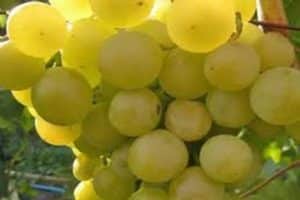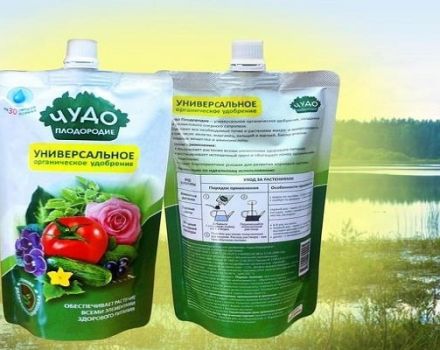Advantages and disadvantages of Charlie grapes, variety description and cultivation
The virtues of cultivated grapes, such as the Charlie grape variety, are familiar to experienced and novice alike. It is unpretentious, fruitful, beautiful - what more could you want? In addition, he is not afraid of the cold, snowy winter typical of the northern regions of Russia. A distinctive feature of the variety is the dark, almost charcoal color of the berries.
History of crop breeding
The variety is relatively young: it was bred and registered in 2015. The second name, reflecting the shade of the peel, is Anthracite. The grapes were obtained by crossing the species Nadezhda AZOS and Victoria, the authorship belongs to E.G. Pavlovsky and the staff of the Kuban University of the Russian Federation who helped him.
Both varieties have been known for over 40 years and are distinguished by their resistance to temperature changes. Charlie inherited the traits of both "parents", generalized and improved them. The tests, during which the preliminary conclusions about the exceptional qualities of the grapes were fully confirmed, were carried out for about 10 years.
Advantages and disadvantages of the variety
The hybrid turned out to be very successful, in short, its advantages are expressed in the following:
- high productivity from season to season;
- resistance to minor damage to the bunch, tolerates transportation well;
- takes root equally well in small areas and in large-scale vineyards;
- peas are minimal;
- not picky about watering, fertilizing, pest control;
- uniform ripening of berries in a bunch;
- rarely affected by insects (wasps);
- frost resistance - up to -24 degrees;
- the buds are not afraid of spring cold snaps, the bush quickly adapts.
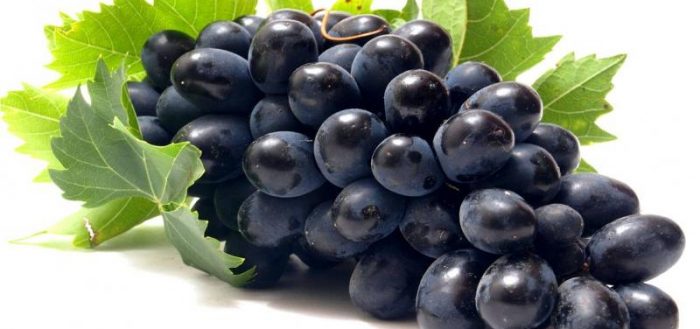
Charlie is exceptionally handsome: elongated, full bunches, densely set with black, shiny berries. With such obvious advantages, the variety is not devoid of disadvantages. This is a light "nightshade" flavor, which is not to everyone's liking, as well as little knowledge of its application in the conditions of personal plots. But the variety has every opportunity to rehabilitate itself, to win the trust of winegrowers.
Features and external parameters of the hybrid
When describing the hybrid, a score of 8.4 points out of 10 is mentioned - quite high for grape varieties. It refers to taste, sweetness, bouquet, acidity.According to official statistics, Charlie brings up to 140 kilograms of ripe berries per hectare.
Unfortunately, when grown at home, this indicator is difficult to confirm (refute) - the wrong scale.
In reality, amateurs get up to 20 kilograms of grapes from one bush. The variety is cultivated not only in Russia, gardeners from Ukraine and Belarus are experimenting with it.
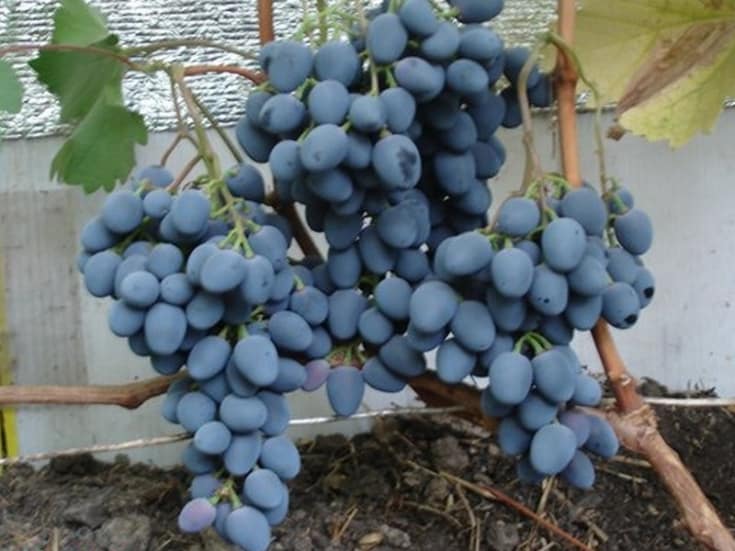
Outwardly, the bush is indistinguishable from its counterparts of other species: of medium height, unremarkable leaf shape of 5 petals. A feature of the variety is the uniform ripening of berries in a bunch and ovaries along the entire length of the shoot, which is not so easy to achieve during selection.
The declared growing season (105-115 days) is actually even shorter, so the species is suitable even for a short summer. The grapes are successfully cultivated with both seedlings and cuttings. Shoots develop like an avalanche, on young bushes there are up to 30 of them. The proportion of those that ripen successfully is 0.9-0.95, which is a good result.
Another important feature: Charlie does not need forced pollination, he has bisexual flowers that can handle it themselves. Each shoot grows up to 7 bunches of grapes, but for better ripening it is recommended to cut 5 of them.
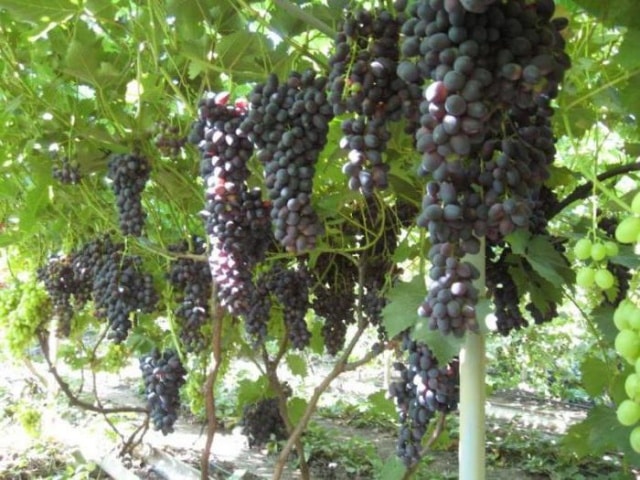
The declared frost resistance is -25 (according to other sources - 24) degrees, this allows the vine to endure the winter without shelter. In the southern regions, it is not required at all. The variety shows sufficient endurance, even with inevitable damage to the foliage, antennae during spring frosts, the bush is restored, returning to its normal state.
On rains, Charlie's hail reacts by slowing development. As soon as the bad weather recedes, the plant will immediately catch up. The bunches are large, the average weight is up to 800 grams (cases of ripening of 2 kg specimens are noted). The length is almost half a meter - 40 centimeters of a conical, tightly packed cone with black berries and the same size. The harvest will not keep you waiting: a year after planting the seedlings, juicy, ripe grapes appear that can hold on for several days without shedding.
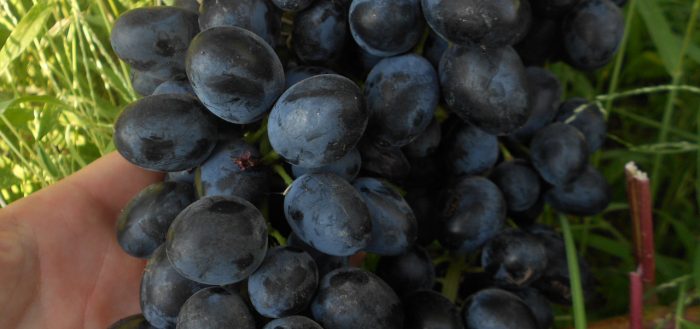
Bush and shoots
The bushes are medium-sized, show high growth rates, easily tolerate pruning, damage by precipitation. Charlie quickly begins to develop shoots, you have to limit their number (especially in young plants) so that the rest can form and grow berries.
Characteristics of berries and brushes
The berries have a characteristic ellipsoidal shape, rich anthracite color, large size and weight (up to 9 grams each). The juice is clear, sweet, with a slight tart aftertaste. The core in the berry is not loose, it contains up to 22% sugar and almost no acid. There are few seeds - 2-3, the peel is dense, but almost not felt, it is easy to chew.
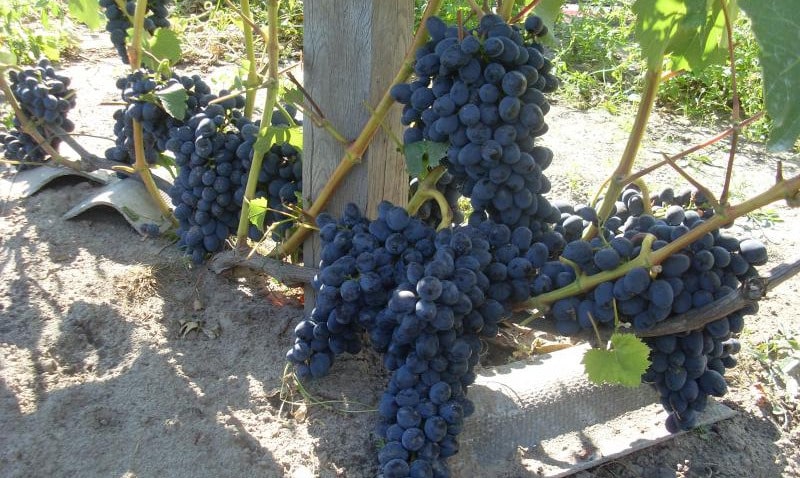
Clusters are heavy, rich in fruits, elongated (usually conical) in shape. Sometimes they reach a length of up to 40 centimeters and weigh more than a kilogram.
Yield
The variety shows high yields; this indicator does not change from season to season. The first time it is necessary to artificially limit the growth of "extra" bunches and berries, removing them. This is a forced measure, otherwise the grapes will not be able to ripen at all.
The yield indicator does not depend on temperature fluctuations in the region and the place of planting, the variety copes well with "atmospheric problems", demonstrates sustainable growth and fertility.
Resistant to frost and disease
Charlie inherited from his ancestors a low sensitivity to low temperatures. In the southern regions, they do not shelter him for the winter at all, in the northern regions they gradually accustom him to the cold. The vine is able to tolerate frost up to -24 degrees without damage, slightly damaged leaves quickly recover as soon as the sun warms up. The variety is not afraid of the most "formidable" and common grape diseases - mildew and oidium.
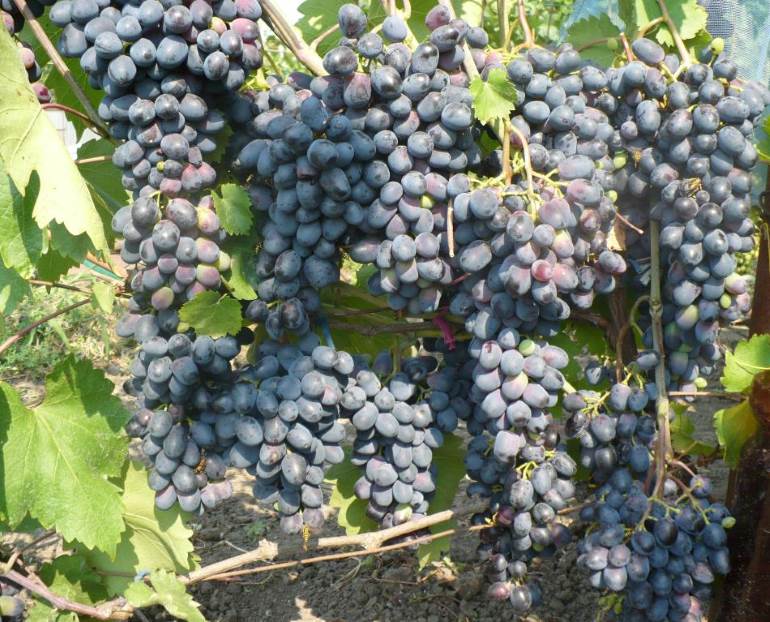
How to plant seedlings
Charlie's planting is no different from that of other varieties. The rule of choosing a sunny place, but sheltered from the wind, is in effect - there the bush feels best. Two cultivation methods are practiced - seedlings and cuttings.
Cuttings
The simplest known method. The length of the prepared cutting is limited to 50-60 centimeters, before planting, the root part is soaked in water (it is possible in a solution of a growth stimulator). An important condition is the air temperature - not less than 16 degrees Celsius.
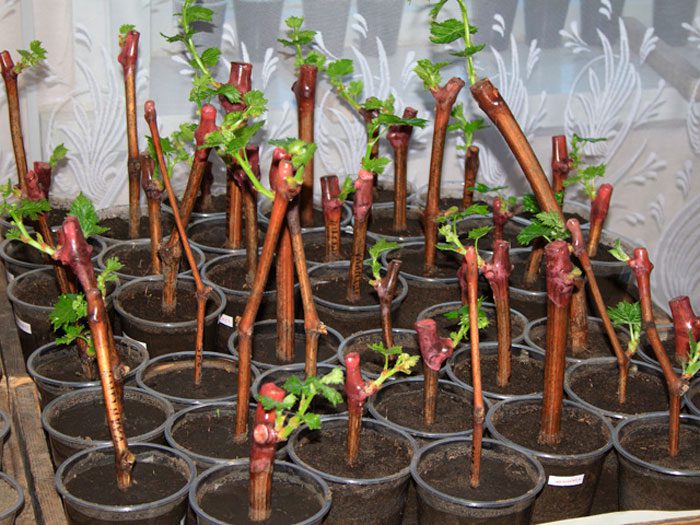
Saplings
Saplings are rooted in spring (not recommended in autumn due to poor survival rate). It is advisable not to use the weak and the sick - this will affect the growth of the grapes. This method is safer and more familiar to planting by cuttings; it is recommended for novice gardeners.
Landing technology
Charlie sits down like other grape varieties: in dry, calm weather, better in spring than in autumn. It is not necessary to scrupulously dig up and fertilize the entire plot; it is enough to prepare the place where the seedling will grow. It is allowed, as protection against gusts of wind, to use nearby bushes of other plants: they will help the grapes to strengthen and not be afraid of cold air.
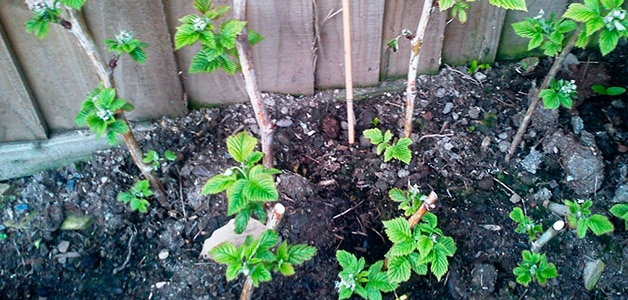
Choosing a landing site
This should be a light, moderately moist area. Any stagnation of liquid in the soil is excluded, they will lead to root rot. Better with well-fertilized soil, drainage and breathability. If you plant grapes under the wall of the building, it will serve as additional protection from the wind.
Required soil composition
Charlie likes dryish, light earthy mixtures, not clayey and not waterlogged. The balance of minerals is ensured by timely fertilization with organics or mineral complexes. Drainage during planting is a necessary measure. Crushed stone, fine bricks, sand are used. A uniformly mixed "cake" is made from soil and fertilizers, which is filled in the inner volume of the hole.
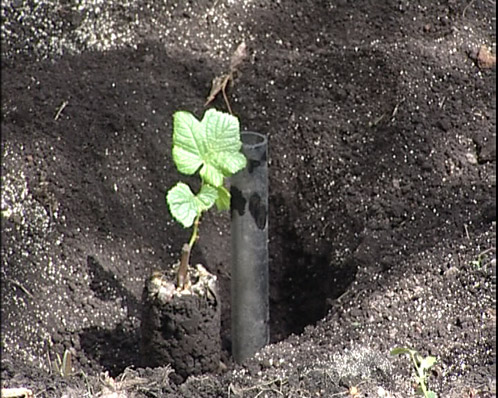
Seating scheme and hole depth
A small hole measuring 60x60 centimeters at the same depth is enough for a seedling. The distance between adjacent bushes is maintained within 1-1.5 meters. If you immediately dig a trench and prepare it, then it will be more convenient to plant the bushes.
Top dressing of young grapes after planting
A full-fledged top dressing is needed for a bush for 3 years of growth, when it has already sufficiently depleted the supply of fertilizers laid down during planting. The main thing here is not to overdo it, adding compost, ash to the root zone, spraying the foliage with a weak solution of mineral compounds.
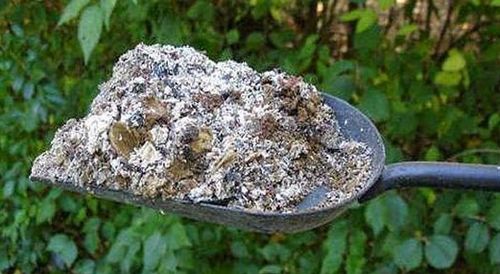
Liana care
Grapes do not require special attention: watering, fertilizing, loosening the root zone and preventing parasites. It is better not to add water than to pour it over. The "thirst" in the variety manifests itself during the period of growth and ripening of berries; before the autumn harvest (15-20 days before) watering is stopped.
Garter bushes
Shoots develop intensively, therefore, so that they do not break under the weight of the bunches, you should worry about supports - trellises, stretched rows of wire, pipes or pickets driven into the ground. The vine is not tied up immediately, but 2 years after planting. For this, fabric strips are used, it is important not to pinch the delicate sleeves and shoots so that they do not dry out.
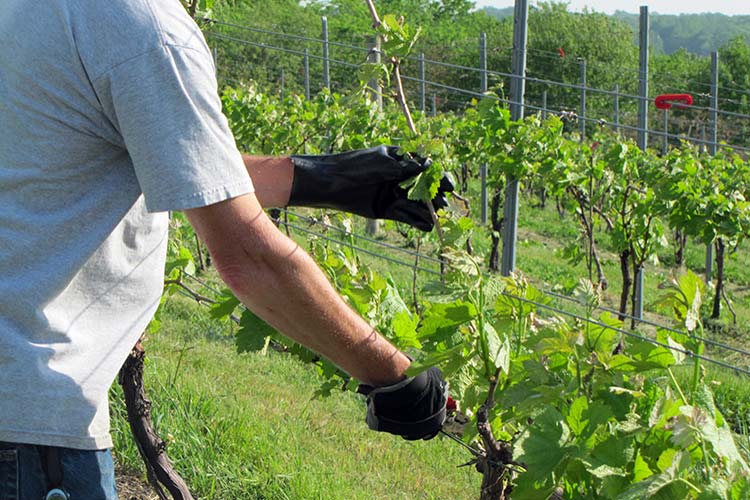
Pruning
Charlie is pruned 3 times a year: spring, summer and fall. Each stage pursues its own goals: first, branches that have died out during the winter are removed, then "sanitary" pruning is carried out to form the profile of the bush, and at the end they are preparing for the cold.
Watering rules
Watering is a delicate procedure: too much liquid will lead to decay of the roots, the lack of it will not allow the berries to develop. Experienced gardeners advise not to add water, so as not to create a swampy area under the stem.
Top dressing
Standard feeding with manure, compost, minerals is used.Usually, the dose incorporated during planting is enough for 3 years, and only then there is a need for additional fertilization.
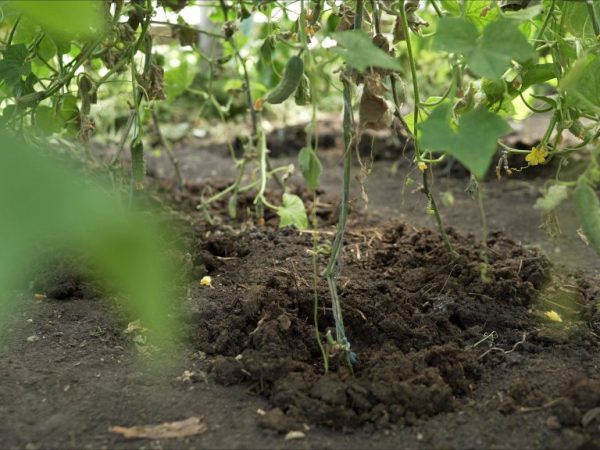
Formation of a fruiting vine
Carried out by pruning: sequentially removing "extra" eyes, you must leave on the bush no more than 30-35. It is important during the summer procedure to open the clusters to the sun, getting rid of the weak and inferior.
Preventive treatments
This group of activities includes spraying with chemicals, loosening, pruning, fertilizing. The variety is resistant to most diseases, but as a preventive care measure, you will have to take care of protection from possible manifestations of fungi and lesions.
![]()
Preparing for winter
The variety belongs to frost-resistant, it is often sheltered in the northern regions (sometimes, to train the vine, it is advised to protect it in the first 2 years of its existence). In the fall, before the first frost, the vine is untied from the support, lowered to the ground and slightly added. It is very important to ensure the stability of the bush in a bent position so that the gusts of wind do not raise it, damaging the delicate branches and buds.
Diseases and pests - ways to deal with them
Charlie is not afraid of mildew, oidium, most pests - it is enough to carry out preventive treatment with insecticides and antifungal drugs.Sometimes it is advised to bury the vine for the winter, creating a roller from the soil, and lay traps with poison around it to prevent damage from garden rodents.

